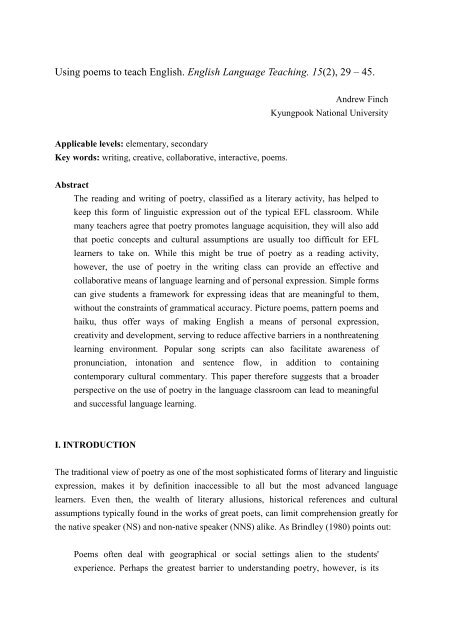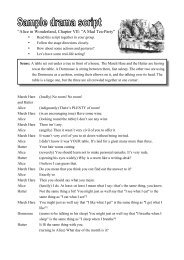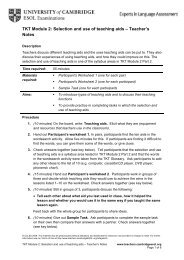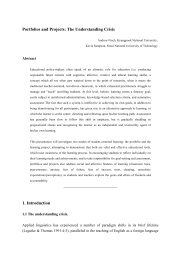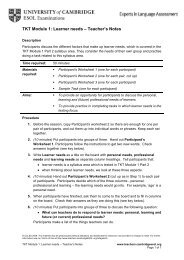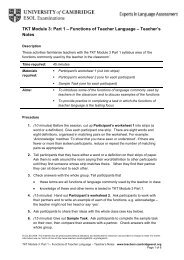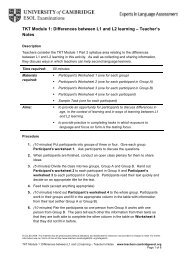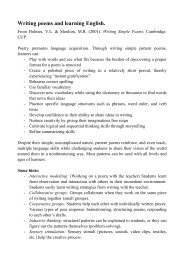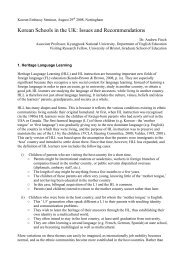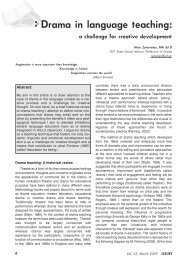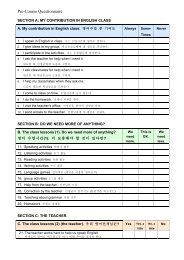Using poems to teach English. English Language ... - Finchpark
Using poems to teach English. English Language ... - Finchpark
Using poems to teach English. English Language ... - Finchpark
- No tags were found...
Create successful ePaper yourself
Turn your PDF publications into a flip-book with our unique Google optimized e-Paper software.
4.Collaborative groups: Groups collaborate when they work on the same piece ofwriting <strong>to</strong>gether (small groups). In appendix B, for example, the <strong>teach</strong>ing aim is quitecomplex: the order of adjectives in a noun-phrase. Rather than indulging in lengthyexplanations and rote-learning of rules, however, the <strong>teach</strong>er has presented andillustrated the learning content above an example poem, encouraging students <strong>to</strong> maketheir own <strong>poems</strong> using this grammatical infrastructure. Working in groups, studentscan now employ problem-solving skills <strong>to</strong> interpret the examples, and can practicedecision-making language (agreeing, disagreeing, suggesting, confirming, errorcorrection,etc.) in the joint composition of a poem (appendix B: Our adjectiveplacement poem).5.Cooperative groups: Cooperation occurs when students help each other withindividually written <strong>poems</strong>. Thus, pattern-<strong>poems</strong> may be passed around inside groupsfor suggestions and even peer-correction (spelling, agreement with the target form,etc.). Helping a peer <strong>to</strong> polish up his/her poem can be very helpful in promotingcomprehension of the learning content.6.Inductive thinking: Structural patterns can be explained <strong>to</strong> students, or they canfigure out the patterns themselves (problem-solving).7.Sensory stimulation: Sensory stimuli (pictures, sounds, video clips, textiles, etc.)help the creative process.8.Sharing: Students’ <strong>poems</strong> can be shared in the classroom (displays, poetry readings,exhibitions, cassette tapes, greeting cards, calendars, etc.).9.Expression: Students can use the target language <strong>to</strong> express feelings and ideas thathave meaning and relevance for them, instead of being restricted (by grammaticalinadequacy) <strong>to</strong> non-personal, syntactical constructions. Thus, appendix D shows an “Iam” poem, in which the writer learns/practices/reviews sentences, subordinateclauses, relative clauses and metaphors, <strong>to</strong> express personal characteristics (curiosity,sounds, sights, desires beliefs, dreams, etc.). Structure, in this highly personal poem,is provided by the combination of I with a verb at the beginning of every line, and bythe final repetition of line 1 at the end. However, there is no restriction on the lengthsof the lines, and students are free <strong>to</strong> explore their visions of themselves.V. POP-SONG SCRIPTSPop songs are popular in the EFL classroom for a number of reasons, though they are rarelyregarded as poetic texts, or as models of creative <strong>English</strong> composition. Rather than usingthem solely for listening comprehension and cloze-tests, however, this paper suggests that
We thus have a simple metrical and rhyming pattern for a poem about lost love (a popular<strong>to</strong>pic for middle school and high school students), and students can work on this template [1]in groups, designing their own version of this pop-song which they know so well. The meterof this poem is simple and consistent and has many instances in which nine short syllablesfollow each other without break: all my troubles seemed so far away. This is significant interms of pronunciation practice, since students who mimic the artists when singing this song,will reproduce the correct phrasal structure of the sentence, and will not be tempted <strong>to</strong>enunciate the Konglish [2] version, in which a neutral vowel sound is added <strong>to</strong> syllablesending with a consonant: troublesuh seemeduh so faruh awayuh. Thus, a visit <strong>to</strong> the localsinging room (no-reh-bang) can be beneficial in terms of acquiring correct appreciation ofsentence-level pronunciation and in<strong>to</strong>nation rules, in contrast <strong>to</strong> a discrete-item study ofminimal pairs, which takes no account of sentence flow and the relative stress of words asthey appear in different combinations.American Pie, by Don McLean (known also for Madonna’s later version) is an example of apop-song which brings the culture of the target language <strong>to</strong> the students. In addition <strong>to</strong>rhyming lines (ago/how, smile/while, chance/dance, shiver/deliver, bride/inside/died), thissong tells of the writer’s reactions <strong>to</strong> an important event in the his<strong>to</strong>ry of American popculture:the death of three pop-music icons (Buddy Holly, The Big Bopper, and RitchieValens) on February 3 rd , 1959, which he links with the demise of the American Dream. Thissong can thus be studied by students for its cultural relevance in terms of the emergence ofpop in the USA, and in terms of the disillusion about American institutions and politicians,which became more prominent during the Viet-Nam War years. This contemporary poeticwork can thus promote awareness of sentence-level pronunciation (That music used <strong>to</strong> makeme smile) and pop-culture, while providing a template for student-directed, collaborativecomposition of a similar poem. It could even spark the creation of a poem about Korean popculture.A long, long time agoI can still remember howThat music used <strong>to</strong> make me smile.And I knew if I had my chanceThat I could make those people danceAnd maybe they'd be happy for a while.But February made me shiverWith every paper I'd deliver.Bad news on the doorstep
I couldn't take one more step.I can't remember if I criedWhen I read about his widowed bride.But something <strong>to</strong>uched me deep insideThe day the music died.VI. CONCLUSIONThis paper has attempted <strong>to</strong> indicate how <strong>poems</strong> and poetry-related activities might enhance<strong>English</strong> language learning at middle school and high-school level. It is suggested that a focuson the beauty of the words of the target language and on their student-directed use in nongrammaticalas well as in grammatical contexts, can promote meaningful and relevantexpression of personal meanings, in addition <strong>to</strong> focusing on particular aspects of structureand syntax. A great depth of poetic expression can be found in pop-song scripts, which voicethe hopes and fears of artists who are often seen as role-models by secondary students. Byusing these scripts as linguistic and affective templates, language students can interact withthe target language, while exploring issues which have deep meaning <strong>to</strong> them.REFERENCESBrindley, D. J. (1980). Breaking the Poetry Barrier: Towards Understanding and EnjoyingPoetry. Paper presented at the Annual Meeting of the International Conference on theTeaching of <strong>English</strong>. Sydney, Australia, 1980.Collins Cobuild <strong>English</strong> Dictionary for Advanced Learners. (2001) Glasgow: Harper Collins.Finch, A. E. (1998). Perception of memory. http://www.finchpark.com/aef/<strong>poems</strong>/06.htm ,accessed February 11th, 2003.Hadfield, C. & Hadfield, J. (1997). Writing Games. Harlow: Addison Wesley Longman Ltd.Moore, J. N. (2002). Practicing Poetry: Teaching To Learn and Learning To Teach. <strong>English</strong>Journal, 91(3), pp. 44-50.
APPENDIX APhrase poem: Teaching points: Verb phrases, Verb, noun, and prepositional phrases,Clauses, Parallel structure. (Holmes & Moul<strong>to</strong>n, 2001, p. 128).Examples:Floating in the air,Gliding through the garden,Drinking from the flowers,Dancing on the leaves,Landing on my finger,Butterflies are freeHot chocolate steaming,Rich aroma rising, White marshmallowsmelting,Cold hands grasping,Big cup waiting,Cocoa in winter tastes good.Pattern:Line 1: Specific phrase or clauseLine 2: Same type of phrase or clauseLine 3: Same type of phrase or clauseLine 4: Same type of phrase or clauseLine 5: Same type of phrase or clauseLine 6: Subject of phrases or clauses.APPENDIX BAdjective placement poem: Teaching points: Adjectives, Order of adjectives in a nounphrase, Vocabulary (Holmes & Moul<strong>to</strong>n, 2001, p. 25).1.determiners2.possessive words3.ordinal numbers4.cardinal numbers5.general description6.size, height, length7.shape8.age, temperature9.color10.origin11.nouns as adjectives12head noun1 .5.... 6 ...8... 9 .....10... 11 ....12a beautiful big old brown Italian leather sofa1 ..3 ...4..... 5 .....8 ..11.. 12our first three pleasant warm winter days1 ...5 ....7 ..9 ..10 ....11 ...12a valuable oval gold French picture frame
Example:We’re taking a trip <strong>to</strong> Egypt,And we’re taking along our favorite things:My fun, rectangular, old blue, Japanese Gameboy,My big, sharp-beaked, old, singing, white and yellow cocka<strong>to</strong>o,My soft, playful, short, small-eared, female black lab,And we’ll have fun!Our adjective placement poemAPPENDIX CAlphabet poem. Teaching points: Letters of the alphabet, parts of speech, phrases, sentencestructure, dictionary usage. (Holmes & Moul<strong>to</strong>n, 2001, p. 38).What I did last summerArgued about my haircutBaked cookies with mumCalled my friends twice a dayDaydreamed a lotE-mailed my friendsFloated on my air-mattress in the poolGave all my old clothes awayHiked <strong>to</strong> the <strong>to</strong>p of the mountainInsisted on having my wayJudged my dad when I had no rightKnew I was wrongLicked ice-cream cones dailyMade <strong>to</strong>ns of new friends at the lakeNavigated the internetOrdered pizza for the girl I baby-satPasted pictures in my scrapbookQuestioned my parents’ rulesRested, rested, and restedScratched my mosqui<strong>to</strong> bitesTold Paul I love himUrged my dad <strong>to</strong> give Paul a chanceVowed <strong>to</strong> be true foreverWondered why I was missing schoolX’d boxes on college applicationYearned for something <strong>to</strong> doZigzagged around the yard
APPENDIX D“I am” poem. Teaching points: Sentences, Subordinate clauses, Relative clauses, Metaphors.(Holmes & Moul<strong>to</strong>n, 2001, p. 112).Example:I am a studious girl who loves <strong>to</strong> read.I wonder if I could someday be an author, <strong>to</strong>o.I hear the voices of characters talking as I read.I see what they look like and what they aredoing.I want <strong>to</strong> create my own s<strong>to</strong>ries for others <strong>to</strong>read.I am a studious girl who likes <strong>to</strong> read.I understand that I may not be a successfulwriterI say that success is in my and I must pursue it.I dream of the joy my writing could give others.I try <strong>to</strong> read and write as often as I can.I hope my dream can come true.I am a studious girl who loves <strong>to</strong> read.Pattern:I am (2 special characteristics).I wonder (something you wonder about).I hear (imaginary sound).I see (imaginary sight).I want (actual desire).I am (first line repeated)I understand (something you know istrue)I say (something you believe in)I dream (something you dream about)I try (something you make an effortabout).I hope (something you hope for).I am (first line repeated)[1] Shostakovich’s first symphony uses the structure of a Haydn symphony as a template.[2] Konglish = Korean-<strong>English</strong>


